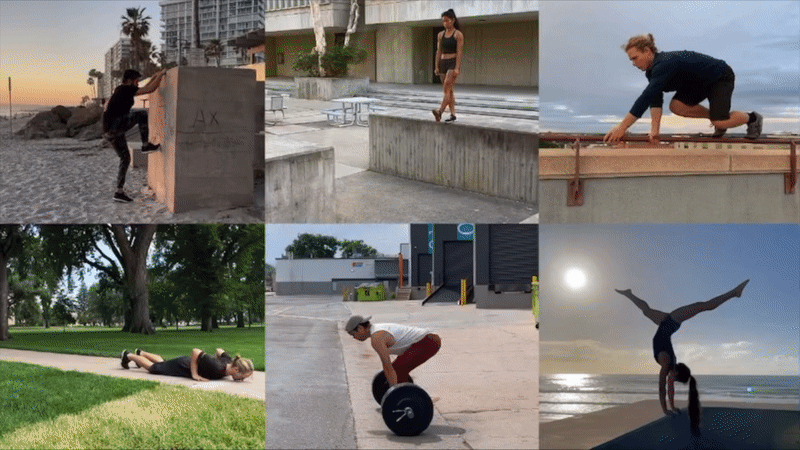🍑
🔥
“Fire under your ass!”
“Bare feet on hot ground!”
“Be less sticky!”
All are useful cues for a common athletic problem—sticking to the ground (or obstacle) for too long during key hand/foot touches when sprinting, jumping, vaulting, climbing, etc.
Moving too slow & sticky is 1 good way to limit yourself from completing your toughest challenges & fastest speed runs. In parkour, tricking, World Chase Tag, and more, you generally want to be fast & springy, not slow & sticky. In the world’s biggest sports like football, basketball, & rugby, top performers are constantly working to get faster at sprinting, jumping, and changing direction.
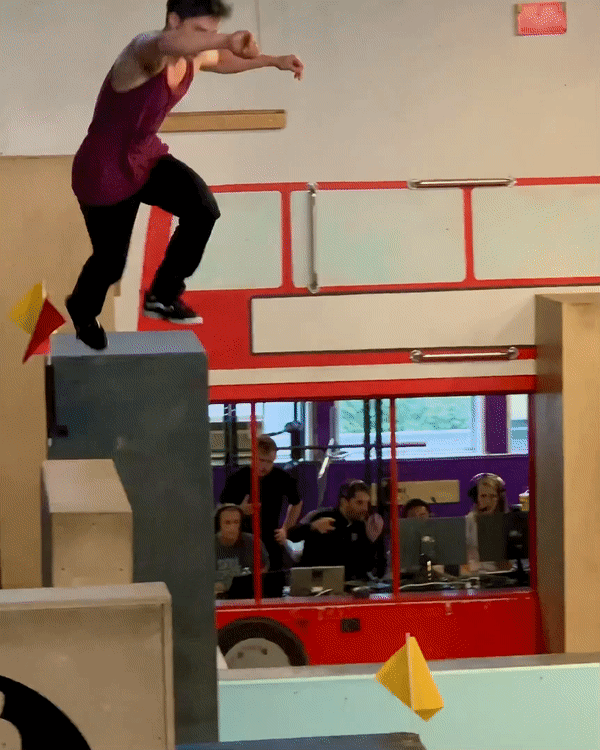
Quick, bouncy drop jump tech in speed parkour competition
ft. Seth Wang, shot by Ryan Ford
Unsurprisingly, a speed parkour athlete who meanders through a course with slow, sticky touches will log a lackluster time. What if being more mindful about contact times could make you a full 1-second faster? It doesn’t seem like much but even shaving off a measly 0.02 seconds from each touch makes a big difference over a full speed run. With many competitive speed parkour courses requiring 50+ touches to finish, a 0.02 second improvement on each touch can make you a full 1-second faster. In elite speed parkour competitions, plus/minus 1 second can easily bump you up or down many spots in the rankings.
50 touches * 0.02 second/touch = 1 second
Being too slow & sticky is a big deal in other sports too. In basketball, football, tennis, World Chase Tag, & more, players must create quick bursts of energy to reach a ball, goal, or opponent as soon as possible. In combat sports, fighters must land a strike or takedown before their opponent can defend or strike first. If you rely on greater ranges of motion and longer contact times to produce the force needed to achieve a competitive goal, you’re at a disadvantage to the athlete who can load, explode, & reach faster.
While there are some maximum power training strategies where shorter contact times result in less performance (e.g. less jump height/distance), most athletes will benefit from creating more power in less time. In most cases, the same amount of power & performance, but in less time, is still an upgrade.
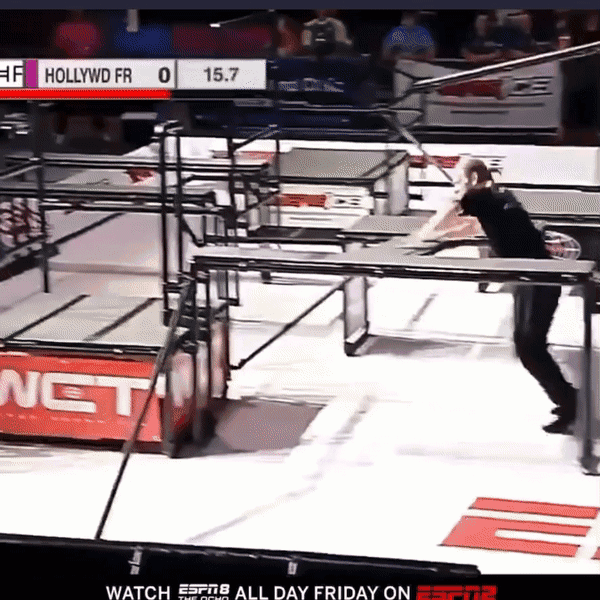
Rapid accel/decel applied to World Chase Tag
source: SportsCenter ft. Olof Wood (Apex ETH)
The secret numbers game behind plyometrics
Every foot and hand touch you make when you move creates a unique force signature that can be measured in a variety of ways. One of the most simple and useful data points from each touch is the length of time you’re in contact with the ground or obstacle.
To calculate a contact time, all you need is a clear video of the contact. You also need to know how many frames-per-second (fps) the video was shot in. The higher the frame rate, the more accurate your results. For example, shooting in 120 fps will result in a more precise measurement than shooting in 24 fps.
Once you have your video, count the frames in which the foot or hand is in contact with the ground/obstacle and then divide by the frame rate. If your foot touched the ground for 10 frames in a 30 fps video, your contact time is 0.3 seconds:
10 frames / 30 frames-per-second = 0.3 seconds
There are other ways to calculate contact times such as special software and force plates. While these setups give more instant & precise feedback, they’re typically not as accessible or versatile. To analyze contact times of complex movements on irregular surfaces, such as a vertical wall run or strides across rails, stick to the video frame counting method.
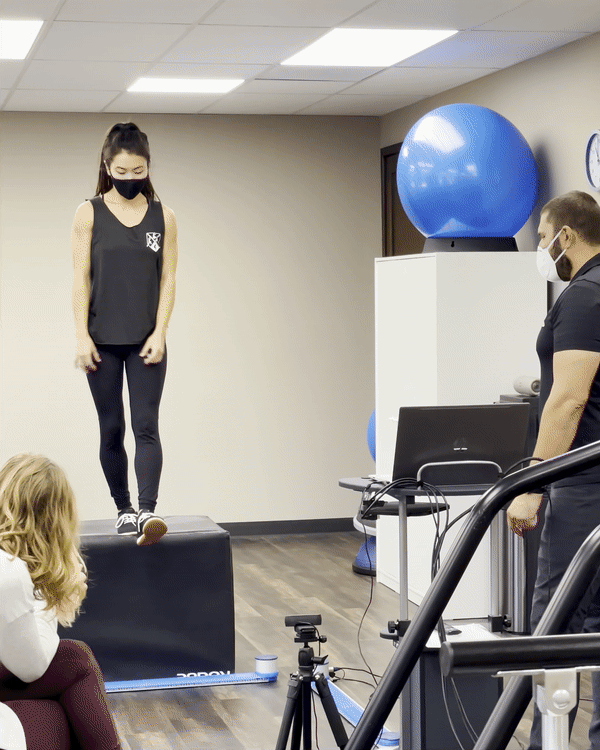
Testing our contact times & more at Prehab San Diego
ft. Taylor Carpenter, shot by Ryan Ford
As visualized in the tweet below, contact times of different movements generally fall into predictable ranges. Elite sprinters at top speed have contact times around .08-.10 seconds. Before reaching top speed, their first few steps fall into a range of 0.14-0.22 seconds. Even slower & stickier are the highest impact plyometrics like depth jumps which have contact times between 0.25-0.45 seconds.
Your optimal contact time depends on factors including the movement and goal you’re trying to accomplish, your strength/mobility levels, and many other variables. You also have to consider whether or not you need maximum power, or if submaximal power will do. While there are exceptions to ideal contact times for various movements, keep these general guidelines in mind:
- Shorter contact times in unilateral jumps vs. bilateral jumps
- Longer contact times in max jumps vs. submaximal jumps
- Shorter contact times at higher speeds vs. slower speeds
- Longer contact times in athletes with low strength and/or high mobility
Ground contact times as a signature to guide training. My latest diagram for an upcoming publication. Making good use of 120fps video during training and return to play process. pic.twitter.com/a0lqLnOwiA
— Derek M. Hansen (@DerekMHansen) January 3, 2018
Why contact times are critical in speed parkour
Quicker contact times in speed parkour competitions are generally 1 of the defining factors between top-ranked athletes and the rest of the field. While there’s lots of strategy, technique, confidence, and other factors that influence who wins, contact times deserve more attention.
In our speed parkour stat blog post from a few years ago, we broke down a variety of statistics from top competitors. Let’s focus on 2 specific match-ups because it highlights how important it is to be less slow & sticky in speed parkour competition. On course 1, the 1st & 2nd place men used an identical number of foot touches. So did the 1st & 3rd place women.
In both cases, the winner was the athlete with the lowest average time per foot touch. Perhaps the winning athletes selected the best skills and strategies for minimizing contact times? Or maybe they just executed every touch with extremely fast contact times? In the most competitive speed parkour competitions, top performers choose the best skills and strategies *and* they execute every contact time as fast as possible.
When running a speed competition, first solve for key skills, strategies, & minimum number of touches. Once these areas are organized and optimized for your current level, enter the mindset of how to speed up every touch.
Seth 🥇 (left) vs. Julian 🥈 (middle)
- Total time (sec): 10.17 (Seth) vs. 10.53 (Julian)
- Total foot touches: 29 vs. 29
- Total foot touch time (sec): 5.79 vs. 6.63
- Average time per foot touch (sec/touch): 0.1997 vs. 0.2286
Kasia 🥇 (left) vs. Taylor 🥉 (right)
- Total time (sec): 15.66 (Kasia) vs. 17.09 (Taylor)
- Total foot touches: 40 vs. 40
- Total foot touch time (sec): 11.04 vs. 13.08
- Average time per foot touch (sec/touch): 0.276 vs. 0.327
Since this 2019 competition in which Taylor was still new to speed parkour, we worked hard for quicker contact times and higher performance. Taylor’s relatively good at strategizing & minimizing hand/foot touches so making faster touches is a bigger training priority.
Partly due to having exceptional levels of mobility, Taylor naturally relies on greater ranges of motion and longer contact times to produce force. A few years ago, she was still relatively strong and powerful, but it wasn’t fully transferring to high performance parkour.
Fast forward a few years and now Taylor’s a much faster, springier athlete. To achieve this goal, we used a multi-faceted approach to improve athletic attributes like strength, stiffness, stability, & speed. Keep reading for more on the key movements & strategies we use to become less slow & sticky.

A stronger, speedier Taylor at Red Bull Al-Andulus 2021
ft. Taylor Carpenter, shot by Silke Sollfrank
General training strategies to be less slow & sticky
Before you worry about training to be less slow & sticky, first explore the question of whether or not you *are* too slow & sticky. Getting faster and springier shouldn’t be a top priority for all athletes. Some athletes may benefit more from working on athletic qualities like strength or mobility.
Film & measure contact times
How do you know if you’re a slow, sticky athlete? By using the video frame counting method explained earlier, you can calculate the contact time of any movement that you can clearly see on camera. This could be a simple depth jump in the weight room, or it could be a complex jump/land combo outside.
Whatever plyometric movement you choose to analyze, film multiple attempts and calculate the contact times. If it’s safe, also try doing the same movement with intentionally longer/shorter contact times. Then compare & contrast each attempt.
Did shorter contact times help you get faster? Did longer contact times offer more control and/or power? What’s the optimal contact time for the current you? What’s the optimal contact time for the *future* you?
Build strength, stiffness, & stability
Another way to become less slow & sticky is to get strong, stiff, and more stable. Often times, these qualities are interconnected. As shown in Sparta Science’s statistical analysis of thousands of athletes, getting stronger at deadlift improves full-body stiffness and average concentric force—which helps you transfer force from eccentric to concentric actions with less ROM & less force leakage. In simple words, Sparta Science collected & crunched big data to show that deadlift is the best heavy, compound lift for slow, sticky athletes.
However, getting stronger & stiffer won’t help if you land in a weak, unstable position. When training movements like jump to shrimp or hard landing, aim to stabilize as quickly as possible. We want your “time to stabilization” to be as close to zero as possible. The fewer balance corrections, the better. If you can instantly stabilize and freeze in perfect position, you’ll theoretically be able to apply more force into each plyometric movement that you do.
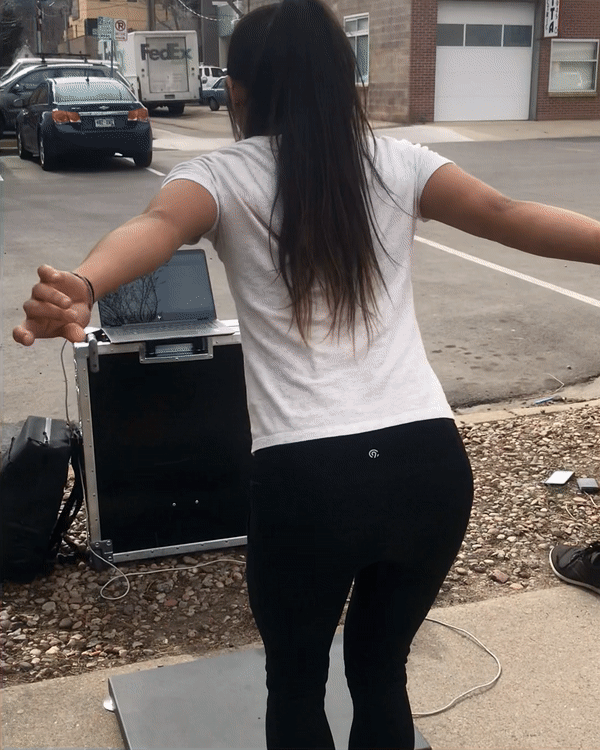
Single-leg stability testing w/ Sparta Science
ft. Taylor Carpenter, shot by Ryan Ford
Be fast & springy in warm-ups & basic skill work
Another way to get faster & springier is to intentionally move in quick, bouncy ways during warm-up or basic skill work. Often times athletes warm-up in lazy, distracted, half-assed ways, which means they’re missing a good opportunity to drill faster touches in a variety of low-risk/low-skill movements.
After you warm up with light, full-body movement to get the joints lubricated, the blood flowing, and the body temperature up, try dynamic warm-up movements like the ones below. Do them with intention and make every foot contact fast & springy, not slow & sticky.

A skip
ft. Ryan Ford, shot by Taylor Carpenter
Focus on speed vs. power in workouts
When training to become a faster, springier athlete, you need to spend some extra time drilling movements that focus on quick contacts, not the longer contacts needed for max height or distance. A great example of this dichotomy is the drop jump versus the depth jump.
The main focus of a drop jump is to get off the ground quickly. Therefore, you want to stay stiffer and use less ROM when absorbing the initial landing and redirecting into the jump.
Alternatively, the primary goal of a depth jump is to rebound off the ground for maximum height or distance. Because of the change in focus, you’ll likely use more ROM and a longer contact time in a depth jump vs. a drop jump.
You can also apply this speed vs. power training concept to other plyometric movements like bounds, rocker jumps, & seiza jump combos. Remember that if your goal is to be less slow & sticky, prioritize quicker contacts (speed focus) when you train these movements, not max height or distance (power focus).
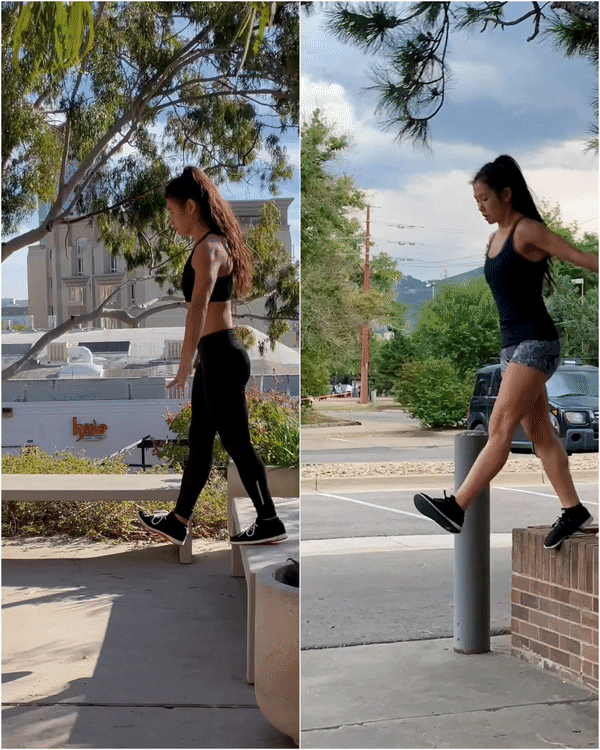
Drop jump (speed focus) vs. depth jump (power focus)
ft. Taylor Carpenter, shot by Ryan Ford
Focus on these movements to get fast & springy
If you want to get faster & springier for your sport, you need to program your workouts carefully. For example, drop jumps & deadlifts are better choices than depth jumps & back squats. Start by selecting movements to develop full-body strength, stiffness, & stability (deadlift, hard & shrimp landings, etc). From there, layer on plyometric movements that emphasize less ROM & shorter contact times (sprint, bound, drop jump, etc).
Deadlift
As 1 of the best movements for strengthening your hamstrings, glutes, & low back, deadlifts are a high bang-for-your-buck lift to add into your workouts. Specifically, deadlifts will boost your horizontal jumps, strengthen your hip-dominant landings, and improve your full-body stiffness/tension for rebounding quickly into the next movement.
Variations & progressions:
Hard landing
Compared to a mid or soft landing where squat ROM is deeper, a hard landing should stay stiffer & taller. Drop to hard landing drills build eccentric strength & power for better rebounding movements. Hard landings also develop faster movement transitions through improved deceleration + change of direction.
In time-sensitive A-to-B challenges with a small drop, hard landings are typically the faster option vs. mid/soft landings. On the other hand, hard landings tend to be more impactful and potentially less sustainable over time. Consider your strengths, weaknesses, and training intentions when choosing which landing to use (e.g. mid/soft for low(er)-impact/longevity, hard for speed/performance, etc).
Variations & progressions:
Shrimp landing
After exploring shrimp squats, try progressing to shrimp landings next. These single-leg landings are an effective way to improve your time to stabilization. Lower times to stabilization often result in stronger, more controlled footwork during strides, tacs, etc.
Shrimp landings are also an important position leading up to the sprinter landing. If you have strong, controlled shrimp landings, it makes it easier to sprint, stride, & jump out of a single-leg landing.
Rudiment hop
No matter what level you’re at, rudiment hops are a simple yet potent way to refine your run/jump/land skills. Learn to control your power in a low(er)-impact way before leaping into the more complex & intense plyometric movements such as bounds, strides, sprints, & running long jumps.
Pogo hop
Unlike the rudiment hop which requires a flat foot contact, pogo hops are up on the balls of your feet. This encourages more ankle stiffness which is good for speed-based movements such as sprints and wall runs. In addition to the lower body gains, practice pulsing/swinging your arms to get more power in each hop.
Variations & progressions:
Drop jump
Drop jumps with a vertical or horizontal rebound are 1 of the best bodyweight movements for building jumping speed & power. However, they’re also intense & impactful.
Before trying, you should have competent squatting/landing skills, and a good amount of lower body strength and mobility. Be cautious and detail-oriented when you do this movement because every injury, imbalance, or error is amplified due to landing/rebounding forces that increase with drop height.
Rather than gently & quietly absorbing the drop from an obstacle, your goal is to rebound into a powerful jump. The purpose is to hone your reactive ability — your ability to transfer a compressive force (landing) into an explosive force (jumping).
Unlike the *depth* jump for height which prioritizes max distance and therefore, longer ground contact times, the main goal of a drop jump is to get off the ground quicker. This means drop jumps will have shorter ground contact times and less height than depth jumps.
Variations & progressions:
Accelerate & sprint
Accelerating/sprinting is a whole-body skill, demanding strong legs, core muscles, and arms. The purpose is to get you across the ground as fast as possible, and when it comes to parkour strength training, it should have a common presence in your workouts.
It’s possible to start a sprint from many different positions, but once you start to accelerate, all sprints tend to look the same. You begin accelerating with your head down and angled forward at your torso so that your legs push the ground behind you, propelling your body faster and faster.
After a handful of initial steps, your chest naturally rises to vertical. Pumping your arms in sync with rapid foot strikes ensures that you keep your speed up. Work on the rapid turnover from one foot to the other, and note how you should be on the balls of your feet for the entire duration of the sprint.
Bound
Bounding is another great way to improve your jumps, strides, and sprints. Experiment with bounding variations such as single-leg, uphill, & more.
While either arm swing style works in most cases, double arm swing enables the greatest force production. If your goal is to build maximum single leg power, or to jump as far as possible, training double arm swing is a must.
The single arm swing technique is also important to develop. Because running relies on single arm swings, the single arm style may outperform when training complex, precise, or submaximal run/jump/land combos.
Variations & progressions:
More movements worth a mention
While the movements above are all great places to start in your quest to become a faster, springier athlete, there are many more good variations & possibilities to try. If you’re looking for more ideas to bust through your speed & power plateaus, here are a few more options to consider:
Rocker step-up jumps
Want to learn more about plyometrics training to help boost your speed & quickness? Check out Parkour Strength Online, the 80/20 of what you should know about parkour strength & conditioning, in a new & improved digital format. Building upon our 15+ years of research & development across multiple parkour schools IRL & remote, this course will help you accelerate athletic development, mitigate injuries, & expand coaching skills.
Ryan Ford is founder of Apex School of Movement, director of Parkour Strength Online course, & author of Parkour Strength Training book.

